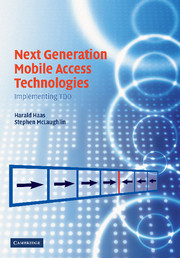Book contents
- Frontmatter
- Contents
- List of abbreviations
- Acknowledgements
- 1 Introduction
- 2 Wireless telecommunications using CDMA and TDD techniques
- 3 Interference and capacity analyses
- 4 Centralised DCA algorithm using the TS-opposing idea
- 5 Distributed DCA algorithm utilising the TS-opposing idea
- 6 UTRA-TDD Opportunity-Driven Multiple Access (ODMA)
- 7 Routing strategies in multi-hop CDMA networks
- 8 Multi-hop DCA
- 9 Radio resource metric estimation
- 10 Interference-based cancellation techniques for TDD
- 11 Smart Antennas for TDD-CDMA Systems
- 12 Cellular OFDMA-TDD
- 1 Derivation of T: Unconstrained Optimisation
- Bibliography
- Index
6 - UTRA-TDD Opportunity-Driven Multiple Access (ODMA)
Published online by Cambridge University Press: 02 September 2009
- Frontmatter
- Contents
- List of abbreviations
- Acknowledgements
- 1 Introduction
- 2 Wireless telecommunications using CDMA and TDD techniques
- 3 Interference and capacity analyses
- 4 Centralised DCA algorithm using the TS-opposing idea
- 5 Distributed DCA algorithm utilising the TS-opposing idea
- 6 UTRA-TDD Opportunity-Driven Multiple Access (ODMA)
- 7 Routing strategies in multi-hop CDMA networks
- 8 Multi-hop DCA
- 9 Radio resource metric estimation
- 10 Interference-based cancellation techniques for TDD
- 11 Smart Antennas for TDD-CDMA Systems
- 12 Cellular OFDMA-TDD
- 1 Derivation of T: Unconstrained Optimisation
- Bibliography
- Index
Summary
In this and the following two chapters the focus moves away from networks which are controlled centrally by a base station to a hybrid cellular network which permits cellular operation as well as peer-to-peer operation. Essentially we consider multi-hop wireless networks based on opportunity-driven multiple access (ODMA) which will be shown to reduce the overall transmission power in a system, to be resilient to shadowing and to potentially increase the coverage compared with single-hop transmission. However, for simple receivers and low user density, the actual capacity of UTRA-TDD may be marginally reduced from the maximum non-relaying capacity. This chapter begins the study of ODMA based systems by analysing the implications of relaying in a cellular scenario compared to a conventional nonrelaying system. Initially the interference is analysed by investigating the effect of reduced transmitted power resulting from reduced path loss for a link. The effect of shadowing is considered and it is shown that a relaying system is able to benefit from increased zero mean lognormal shadowing by utilising the diversity of paths available. A correlated shadowing model is developed from a previous model considering both distance and angle of arrival (Klingenbrunn and Mogensen, 1999) to include the shadowing correlation between all transceivers, as they may all be available to receive in a relaying environment. It is shown that while this affects the interference pattern the perturbation is not significant.
- Type
- Chapter
- Information
- Next Generation Mobile Access TechnologiesImplementing TDD, pp. 157 - 185Publisher: Cambridge University PressPrint publication year: 2008

